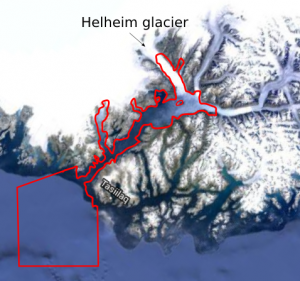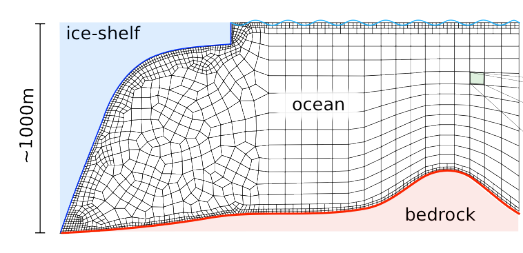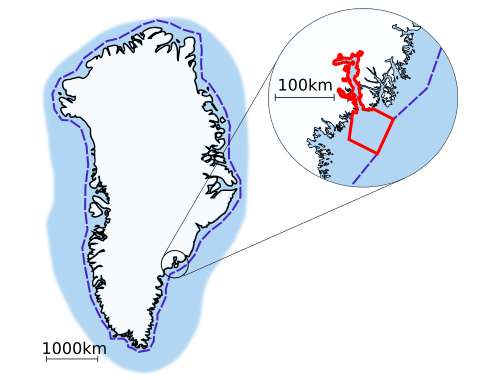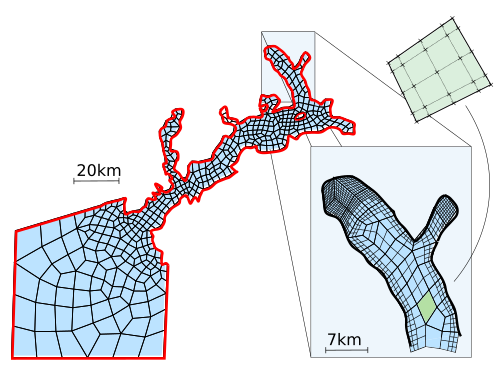The goal of this project is to build a non-hydrostatic ocean model, which can use unstructured meshes with local refinement both in the horizontal and vertical directions. The model uses high-order unified continuous/discontinuous Galerkin methods for the 3D incompressible Navier-Stokes equations. NUMO draws its lineage from the atmospheric model NUMA.
The primary application of NUMO is high-resolution simulations of Greenland fjords, with a particular focus on fine-scale interactions with marine terminating glaciers. We aim to represent the fjord bathymetry and coastlines realistically. NUMO is designed to two-way couple to Earth System Models to facilitate its use in regional and global climate simulations.
Motivation
Ice-sheet/ocean interaction in narrow fjords around Greenland is one of the key outstanding challenges in modeling studies of climate change and sea level rise. The runoff from Greenland's ice sheets is a significant factor in global sea-level rise, yet current computational models are not able to resolve fine-scale processes in the fjords without prohibitive computational costs. This problem arises due to a vast difference in scales between the open ocean (~1000km) and fjord (~1km) as well as a geometrically complicated coastline. The goal of NUMO is to represent the fine scale processes at ice/ocean interface and couple them with global or regional ocean circulation model.

Sermilik Fjord
The long-term goal of the project is to simulate an entire Greenland's coastal ocean and couple this simulation to a full-size regional or global climate model. The immediate goal, which is to demonstrate the model capabilities, focuses on the Sermilik fjord - Helheim glacier system, which is one of the main contributors of fresh water to the ocean around Greenland, and for which a substantial set of measurements is available.
Greenland coastal ocean
The coastline of Greenland is laden with deep and geometrically complicated fjords, which makes the simulation of coastal ocean processes very difficult. Current global or regional ocean models are not able to resolve all features of Greenland's coastline due to either mesh geometry constraints (i.e. structured grids), or computational cost. For that reason, we are working on a new model, which will be able to account for all the small scale processes, including the interactions of glaciers and ocean as well as the circulation within fjords. The figure above shows the interface (dashed blue line) between the general circulation model and NUMO. Our model will simulate all the processes between the interface and the coast of Greenland.
Single fjord setup
As a proof of concept, we focus on a simulation of Sermilik Fjord (in the blow-up above), which is both geometrically complicated and has a marine-terminating Helheim glacier. The red solid line represents the computational domain we are going to use to simulate processes within the fjord. The domain connects the deep fjord and ice-sheet interface with the open ocean outside.
Unstructured non-conforming mesh
To represent the complicated geometry of the fjord, we use an unstructured hexahedral mesh (here shown as quadrilaterals in 2D). We can vary the resolution of the mesh from large elements at the open ocean interface to very small elements inside the fjord.
Local mesh refinement
On top of the unstructured mesh, we can perform a non-conforming local refinement. This procedure allows us to subdivide arbitrarily chosen elements into smaller (non-conforming) elements. As a result, we can refine the mesh only locally where it is needed, keeping the rest of the domain coarse. At the blow-up of the above figure, we have refined the mesh multiple times around the Helheim glacier interface and left the original coarse mesh unchanged. This technique allows us to capture important processes at the ice-sheet interface while keeping the computational cost of the entire simulation reasonable.
High order polynomial expansion
The element refinement is not the only factor determining the resolution of our model. Within each element there exist a grid of carefully selected nodal points which allow for high-order polynomial expansion of the solution within the elements. This approach is a central feature of continuous/discontinuous Galerkin methods, which we describe in more detail in the Model design section. The number of nodal points within elements can be arbitrarily chosen to control the resolution and accuracy of NUMO.
Vertical mesh distribution
Since NUMO is a non-hydrostatic model and has unstructured mesh capability, there is no need to adhere to traditional layered ocean coordinate systems. We anticipate that non-hydrostatic effects will play a dominant role in the ice sheet interface flows and want to apply the fully unstructured mesh to the ice shelf cavity, with ultra-high resolution near the grounding line to represent the subglacial discharge and the effects of the turbulent plume at the ice shelf base. Outside the ice shelf cavity, the vertical mesh can be kept layered, to better represent a more balanced state of the ocean in that region.



